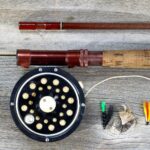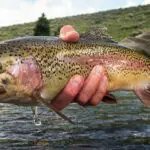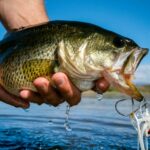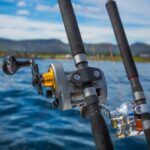Ice fishing is a favorite activity for many who live in cold environments and for fishermen who live in places with icy winters. Ice fishing can be surprisingly effective and is great fun, but the most important factor in ice fishing success is the fishing line used. Which fishing line is best for ice fishing?
The best fish line for ice fishing is a personal preference for each angler. However, fluorocarbon lines tend to perform very well for ice fishing. Most anglers use fluorocarbon lines or braided lines with a fluorocarbon line leader to combine the strength of braided and invisibility of fluoro lines.
There are several fishing line options available for ice fishing, some of which are specifically designed for ice fishing, but not all fishing lines work well for this type of fishing. It is critical that the ice angler chooses the right line, but how do you know which line to choose? What makes a fishing line good for ice fishing? Let’s find out!
What Fish Line Is Best For Ice Fishing?
There are several ice fishing line options on the market. Every type of fishing line has strengths and weaknesses, and it is the responsibility of the angler to choose a line based on these factors. The angler should also choose a line based on their target fish, the temperature of the water they are fishing in, and the conditions they are fishing in.
There are generally three types of fishing lines that ice anglers turn to when fishing in frozen water: monofilament lines, fluorocarbon lines, and braided fishing lines.
Regular fishing calls for braided or monofilament lines, but ice fishing adds the option for fluorocarbon lines, which have a significant advantage in some ice-fishing scenarios.
Each of these lines has pros and cons to consider. The line that you choose for ice fishing should be based on the temperature of the water you are fishing in, the depth you are fishing at, and the fish you want to catch.
Fishing lines and fishing rigs respond differently in freezing cold water. The water becomes denser at lower temperatures, and fishing rigs become more buoyant as a result.
The fish that are likely to be caught while ice fishing can be difficult to catch, and they are far less likely to bite in frigid water than when the water is warm. This makes ice fishing far more challenging, and anglers must use everything they can to improve their success while fishing.
This means that the best fishing line is a line that can handle the cold, is resistant to abrasion from the ice, is as invisible as possible, sinks quickly, and can handle the weight of any fish the anglers may catch.
Most ice anglers, therefore, prefer using fluorocarbon fishing lines. These lines sink rather than being neutrally buoyant in the water. They are very tough, they are invisible to fish, and they can handle the weight of any fish you may catch while ice fishing.
However, there are negatives to using fluorocarbon lines as well. Many ice fishermen would rather use monofilament for the sake of strength and ease of use, and many prefer braided lines for their strength and high sensitivity.
Every angler must decide which line they prefer based on their own fishing style, the fish they want to catch, and how their gear performs in the water.
The best ice fishing line on paper is a medium-test fluorocarbon line, but your experience and preferences may differ based on how you like to fish.
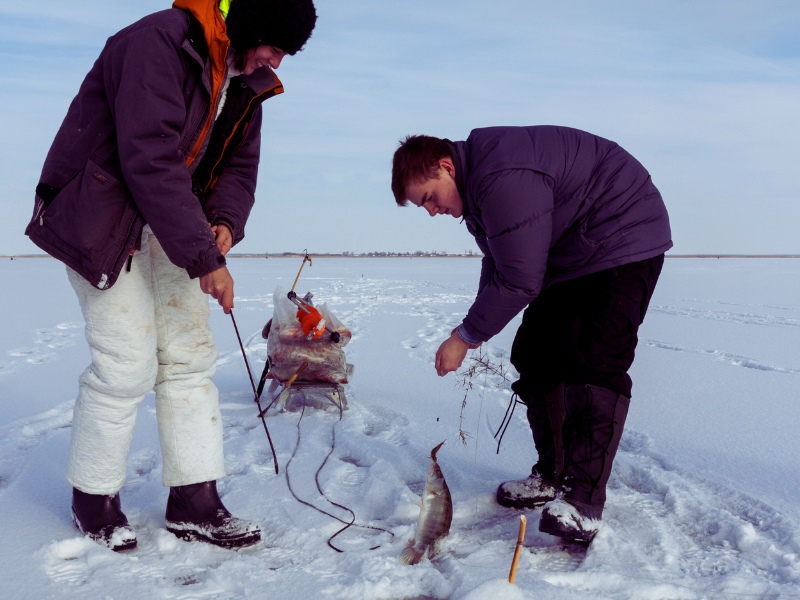
What To Look For In Good Ice Fishing Line
We have established that fishing with fluorocarbon lies is the preference of many anglers, and it can be the best ice fishing line to use in certain situations, but there are several factors to consider when fishing in frigid waters, especially regarding the line you choose to use.
This leads many anglers to wonder what line to choose when ice fishing and what they should look for when choosing the best line for their circumstances and fishing preferences.
There are many factors that make a fishing line good for ice fishing, but the most important attributes of the line for this type of fishing include the following:
- The weight of the line.
- The weight the line can hold.
- The visibility of the line in the water.
- How resistant the line is to abrasions.
- The line memory.
- How the line reacts in cold water.
- The stretch of the line.
- How absorbent the line is.
- How much the line costs.
Let’s take a closer look at each of the fishing line factors and explore the effect they have on ice fishing. This will help you to determine which line is best for you when ice fishing and can result in much higher fishing success.
Line Weight
The weight of the fishing line is an important factor, as some lines are heavier than others, and it is important to understand how the weight of the fishing line causes it to react in frigid water.
Very cold water is denser than warmer water, which means that if a fishing line is neutrally buoyant in warm water, it is likely to float in frigid water.
This can make it very difficult to ice fish at deeper depths, as the line will cause the rog to float at a higher depth than expected, and it causes the rig to sink much more slowly than required.
Fluorocarbon fishing lines are the heaviest lines regarding physical weight, which is one reason why ice anglers prefer this line. Fluoro lines sink the quickest, they do not cause rigs to float, even if the rig is ultralightweight, and they allow anglers to reach their desired fishing depth easily.
Mono and braided lines are more likely to float in frigid waters, but braided lines still perform better than mono lines in this instance. Mono lines can cause ultralight rigs to float in the water and significantly slow down the sinking rate of fishing rigs, which can be frustrating.
However, this is only an issue if the line is not weighted correctly or if the angler chooses not to use sinkers for the sake of reducing line visibility.
Line Test
Line test is the weight that a fishing line can hold before it snaps or stretches to its near-breaking point.
The test of a fishing line is important in ice fishing, as you never know how big the fish that you may catch are. Ice fishing typically yields smaller fish, as most of the larger fish species dwell close to the waterbed and are more difficult to catch, but anything is possible.
If you are bottom fishing while ice fishing, it is critical that the line you use can handle heavy weights, but if you are fishing closer to the surface, the line can be lighter and is not required to handle very heavy fish.
However, braided fishing line can handle significantly more weight at a lower test than any other line. This means that many ice anglers prefer braided lines when fishing at medium depths, as the line can be light enough to use a light rig and reel but still strong enough to handle anything they may catch.
Monofilament lines are the weakest of all lines and must be a higher test to handle heavier fish, while fluoro lines are slightly stronger and can handle heavier weights at a lower test.
This is a critical consideration when choosing the line you use for ice fishing. If you want to catch heavy fish, use a braided line, but if you are targeting smaller, more lightweight fish, a lighter test line is better and will yield better results.
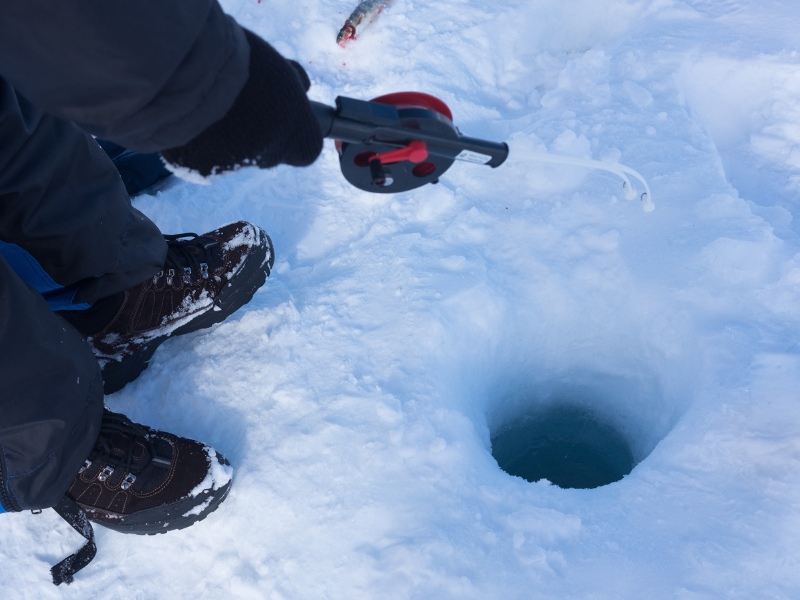
Line Visibility
Line visibility is among the most critical aspects to consider when choosing a line for ice fishing.
Frigid water can be very clear, and the fish that are present and eating in frigid water tend to be very weary. This means that using a line that is very easy to see underwater is likely to scare off certain fish species.
Fish that are line-shy will rarely bite a rig that has a visible line attached. This means that depending on the type of fish you are targeting and the water you are fishing in, using a line that is invisible in the water is an advantage that cannot be underestimated.
Fluorocarbon fishing lines become completely invisible in water. The construction of these lines and the material that they are made of renders them invisible even in the clearest water, which is another reason why many ice anglers prefer using this type of line.
Line-shy fish are unlikely to notice fluoro fishing lines, and this line drastically increases the success of fishing rigs that use this line in most ice fishing conditions.
However, line visibility becomes less of a priority when fishing in deep water or when the water is not clear.
In this example, it may be better to use a braided line due to the higher sensitivity of the line and the heavier weight that this line can handle. The braided line is the most visible underwater and is not ideal good fishing in clear water at shallow depths, but it works well in murky water at deeper depths.
Monofilament line is a good in-between regarding line visibility. It is more visible underwater than fluoro but less visible than braided line, which can make it the ideal choice in certain ice fishing conditions.
Line Abrasion Resistance
Line abrasion resistance is another critical factor in ice fishing lines.
Ice is abrasive. This seems to be a fact that not many anglers consider, but the reality is that fishing through a hole in a sheet of ice is very likely to result in a broken fishing line as the line rubs against the edges of the hole.
Fish that are actively eating during the winter tend to be predatory fish, which means that there are more fish in the water with sharp teeth that are likely to sheet your line as well.
For these reasons, any line that is used for ice fishing, especially when fishing deep or when leaving your line in the water for a long time, must be as resistant to abrasions as possible. A line that is easily broken is not a good line for ice fishing.
Braided lines have the best abrasion resistance of any fishing line and tend to be the toughest overall. These lines are best for fishing for long periods or when your line is likely to be cut or broken by rough ice.
Monofilament line has the least abrasion resistance and is the most likely to break, and must therefore be used with much caution while ice fishing.
Fluorocarbon fishing lines are slightly tougher than mono lines and less susceptible to abrasions, but they can still be easily broken by rough ice holes and fish with sharp teeth.
If you find yourself losing rigs due to line abrasion, it is time to switch to a braided line that can handle the damage better.
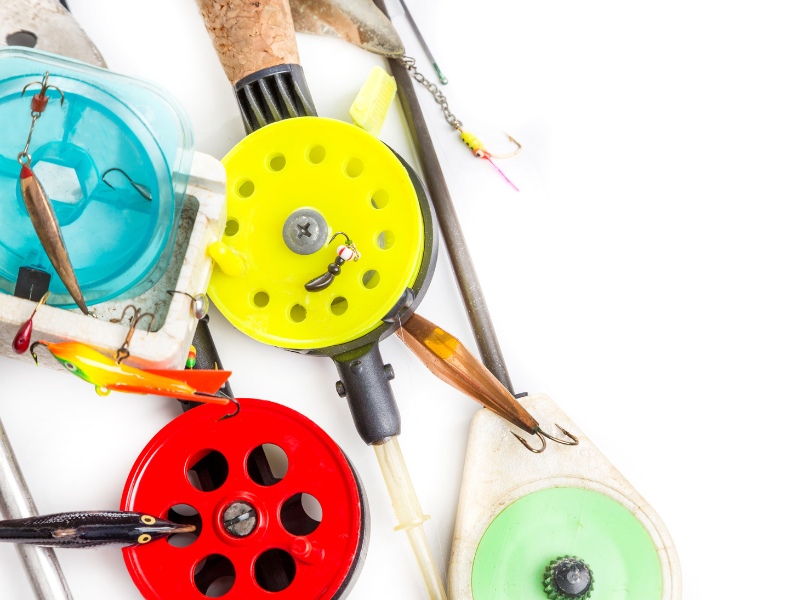
Line Memory
Line memory is another factor many anglers forget about, but it is important for ice fishing, as line with more memory, especially when stretched, tend to cause spin in the water, which can be detrimental to your fishing success.
Fishing line memory is the way the line retains its shape when spooled. If the line has a lot of memory, it will twist as it spools, retain a twisted shape, and cause your rig to spin when it gets into the water.
This rotational movement is off-putting for many fish, and they tend to avoid rigs that move in this way. Most lines only develop this issue as they are used for longer periods of time. You can avoid this issue with any line by switching to a new spool frequently, but it is better, in some instances, to use a line that has less memory.
Fluorocarbon and monofilament lines have the most line memory. Braided lines have no memory and never cause a line to spin.
Monofilament fishing line has the most memory, especially after the line has been stretched, which means that this issue is most prevalent in mono lines.
If you fish with mono lines, try to limit the way the line stretches as much as possible, and ways watch your line for spinning. Change to a new spool if your rig begins to spin wildly as it sinks.
Braided lines never have this problem, which is another reason why they are so good for very deep ice fishing. If you fish deep water and want to avoid issues caused by line memory, then use braided line as much as possible.
Many anglers use braided line with a long fluorocarbon leader to avoid this issue and retain the usability of the line.
Line Freezing
Ice fishing presents unique fishing problems that are not a factor in any other type of fishing, such as line freezing. The water can get so cold when ice fishing that it can cause the line itself to freeze or become rigid in the water.
This is a serious issue. Line freezing causes the line to become brittle and more likely to break. It reduces the stretch of the line, reduces sensitivity, and can make the lie very difficult to work with.
Braided lines tend to freeze much more quickly than other line types, but they are also stronger, which reduces the problems caused by freezing. Monofilament and fluorocarbon fishing lines are less likely to freeze, but when they do, they are far more likely to break.
The temperature of the water you are fishing should be an important consideration when choosing which like to use. If the water is too cold for mono or fluoro lines, it is important to use braided line or choose a line that is designed for colder water to prevent freezing.
Line Stretch
Line stretch is important to consider in fishing lines for ice fishing, as the way the line stretches determines how fish take the line and how sensitive the line is for the angler using it.
Lines with little or no stretch are far more sensitive and easier to use for anglers, but lines with more stretch tend to act more naturally in the water, which makes some fish more likely to take the lure or bait.
Braided lines have no stretch at all. Fluoro lines have some stretch, but monofilament lines have the most stretch.
This means that mono lines are most likely to cause more natural behavior from fishing rigs, but braided lines are easier to use in cold water due to higher sensitivity, which alerts the angler of a set hook much more quickly.
The type of fish you target should be the biggest deciding factor here. If the fish you target catch are notorious for only taking naturally moving rigs, then use mono line. If the fish you target require greater sensitivity to catch, then use a good, braided line that maximizes sensitivity.
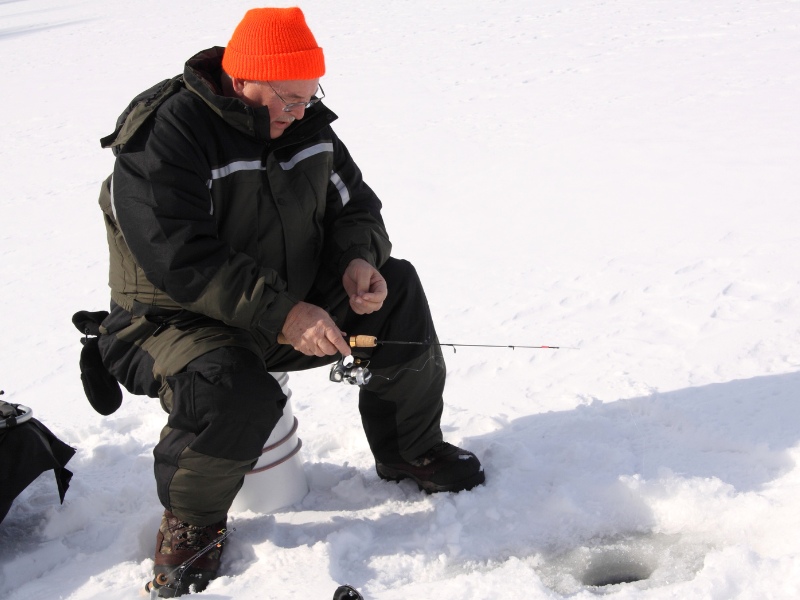
Line Price
The final factor to consider when choosing an ice fishing line is the price of the line.
The best line for ice fishing is a line that is as affordable as possible, with the best performance possible.
For most anglers, this is a light-test braided line. Mono line is the cheapest line; fluoro lines are the most expensive, and braided lines are in-between and can have excellent performance if used well.
If you are looking for the best line for the price, a braided line is usually the best option. These lines also last much longer than mono and fluoro lines and are, therefore, more worthwhile buying.
Conclusion
The best fishing line for ice fishing is dependent on the type of fish the angler targets, the water temperature, the target depth the angler wants to fish, and the style of the individual angler.
The best fishing line for ice fishing is usually a fluorocarbon line, but many anglers prefer a combination of braided and fluorocarbon lines for ice fishing. Take the time to find the right line for you, and ice fishing will be far easier and more successful.
- Do You Need An Indicator For Nymph Fishing? - November 16, 2023
- Fishing Safety Tips For Families - September 25, 2023
- What Is The Best Time To Night Fish At A Lake? - September 18, 2023


